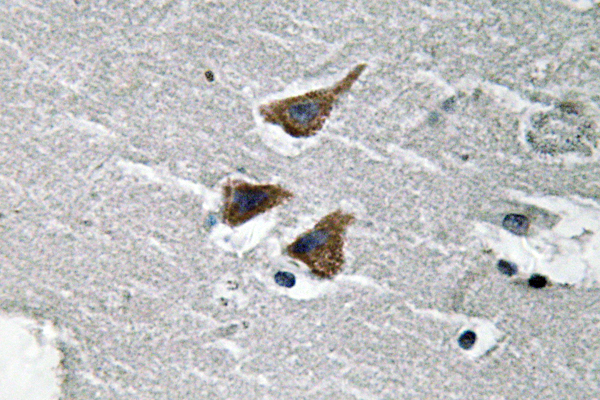uPA Polyclonal Antibody
- Catalog No.:YT4823
- Applications:IHC;IF;ELISA
- Reactivity:Human;Rat;Mouse;
- Target:
- uPA
- Fields:
- >>NF-kappa B signaling pathway;>>Complement and coagulation cascades;>>Transcriptional misregulation in cancer;>>Proteoglycans in cancer;>>MicroRNAs in cancer;>>Prostate cancer
- Gene Name:
- PLAU
- Protein Name:
- Urokinase-type plasminogen activator
- Human Gene Id:
- 5328
- Human Swiss Prot No:
- P00749
- Mouse Swiss Prot No:
- P06869
- Immunogen:
- The antiserum was produced against synthesized peptide derived from human uPA. AA range:190-239
- Specificity:
- uPA Polyclonal Antibody detects endogenous levels of uPA protein.
- Formulation:
- Liquid in PBS containing 50% glycerol, 0.5% BSA and 0.02% sodium azide.
- Source:
- Polyclonal, Rabbit,IgG
- Dilution:
- IHC 1:100 - 1:300. ELISA: 1:40000.. IF 1:50-200
- Purification:
- The antibody was affinity-purified from rabbit antiserum by affinity-chromatography using epitope-specific immunogen.
- Concentration:
- 1 mg/ml
- Storage Stability:
- -15°C to -25°C/1 year(Do not lower than -25°C)
- Other Name:
- PLAU;Urokinase-type plasminogen activator;U-plasminogen activator;uPA
- Molecular Weight(Da):
- 49kD
- Background:
- This gene encodes a secreted serine protease that converts plasminogen to plasmin. The encoded preproprotein is proteolytically processed to generate A and B polypeptide chains. These chains associate via a single disulfide bond to form the catalytically inactive high molecular weight urokinase-type plasminogen activator (HMW-uPA). HMW-uPA can be further processed into the catalytically active low molecular weight urokinase-type plasminogen activator (LMW-uPA). This low molecular weight form does not bind to the urokinase-type plasminogen activator receptor. Mutations in this gene may be associated with Quebec platelet disorder and late-onset Alzheimer's disease. Alternative splicing results in multiple transcript variants, at least one of which encodes an isoform that is proteolytically processed. [provided by RefSeq, Jan 2016],
- Function:
- catalytic activity:Specific cleavage of Arg-|-Val bond in plasminogen to form plasmin.,function:Specifically cleave the zymogen plasminogen to form the active enzyme plasmin.,online information:Urokinase entry,pharmaceutical:Available under the name Abbokinase (Abbott). Used in Pulmonary Embolism (PE) to initiates fibrinolysis. Clinically used for therapy of thrombolytic disorders.,PTM:Phosphorylation of Ser-158 and Ser-323 abolishes proadhesive ability but does not interfere with receptor binding.,similarity:Belongs to the peptidase S1 family.,similarity:Contains 1 EGF-like domain.,similarity:Contains 1 kringle domain.,similarity:Contains 1 peptidase S1 domain.,subunit:Found in high and low molecular mass forms. Each consists of two chains, A and B. The high molecular mass form contains a long chain A which is cleaved to yield a short chain A. Binds LRP1B; binding is followed by interna
- Subcellular Location:
- Secreted .
- Expression:
- Expressed in the prostate gland and prostate cancers.
- June 19-2018
- WESTERN IMMUNOBLOTTING PROTOCOL
- June 19-2018
- IMMUNOHISTOCHEMISTRY-PARAFFIN PROTOCOL
- June 19-2018
- IMMUNOFLUORESCENCE PROTOCOL
- September 08-2020
- FLOW-CYTOMEYRT-PROTOCOL
- May 20-2022
- Cell-Based ELISA│解您多样本WB检测之困扰
- July 13-2018
- CELL-BASED-ELISA-PROTOCOL-FOR-ACETYL-PROTEIN
- July 13-2018
- CELL-BASED-ELISA-PROTOCOL-FOR-PHOSPHO-PROTEIN
- July 13-2018
- Antibody-FAQs
- Products Images

- Immunohistochemistry analysis of uPA antibody in paraffin-embedded human brain tissue.



